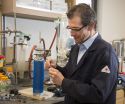(Press-News.org) VIDEO:
The Arctic Ocean is absorbing more of the sun's energy in recent years as white, reflective sea ice melts and darker ocean waters are exposed. The increased darker surface area...
Click here for more information.
NASA satellite instruments have observed a marked increase in solar radiation absorbed in the Arctic since the year 2000 - a trend that aligns with the steady decrease in Arctic sea ice during the same period.
While sea ice is mostly white and reflects the sun's rays, ocean water is dark and absorbs the sun's energy at a higher rate. A decline in the region's albedo - its reflectivity, in effect - has been a key concern among scientists since the summer Arctic sea ice cover began shrinking in recent decades. As more of the sun's energy is absorbed by the climate system, it enhances ongoing warming in the region, which is more pronounced than anywhere else on the planet.
Since the year 2000, the rate of absorbed solar radiation in the Arctic in June, July and August has increased by five percent, said Norman Loeb, of NASA's Langley Research Center, Hampton, Virginia. The measurement is made by NASA's Clouds and the Earth's Radiant Energy System (CERES) instruments, which fly on multiple satellites.
While a five percent increase may not seem like much, consider that the rate globally has remained essentially flat during that same time. No other region on Earth shows a trend of potential long-term change.
When averaged over the entire Arctic Ocean, the increase in the rate of absorbed solar radiation is about 10 Watts per square meter. This is equivalent to an extra 10-watt light bulb shining continuously over every 10.76 square feet of Arctic Ocean for the entire summer.
Regionally, the increase is even greater, Loeb said. Areas such as the Beaufort Sea, which has experienced the some of the most pronounced decreases in sea-ice coverage, show a 50 watts per square meter increase in the rate of absorbed solar radiation.
"Advances in our understanding of Arctic climate change and the underlying processes that influence it will depend critically upon high quality observations like these from CERES," Loeb said.
As a region, the Arctic is showing more dramatic signs of climate change than any other spot on the planet. These include a warming of air temperatures at a rate two to three times greater than the rest of the planet and the loss of September sea ice extent at a rate of 13 percent per decade.
While these CERES measurements could ultimately become another of those signs of dramatic climate change, right now scientists say they have obtained the bare minimum of a data record needed to discern what's happening over the long term.
Getting data beyond 15 years will allow scientists to better assess if recent trend falls outside the realm of natural variability, said Jennifer Kay, an atmospheric scientist at the Cooperative Institute for Research and Environmental Science at the University of Colorado.
"We need long time series to detect climate change signals over the internal variability. For example, observed sea ice loss over the last 30 years cannot be explained by natural variability alone." Kay said. "Fifteen years is long, but climate is often defined as the average over 30 years - so we are only half-way there with the CERES observations."
Kay and colleagues have also analyzed satellite observations of Arctic clouds during this same 15-year period. Kay's research shows summer cloud amounts and vertical structure are not being affected by summer sea ice loss. While surprising, the observations show that the bright sea ice surface is not automatically replaced by bright clouds. Indeed, sea ice loss, not clouds, explain the increases in absorbed solar radiation measured by CERES.
Increasing absorbed solar radiation is causing multiple changes in the sea ice cover, said Walt Meier, a sea ice scientist from NASA's Goddard Space Flight Center, Greenbelt, Maryland. Two of those changes include the timing of the beginning of the melt season each year and the loss of older, thicker sea ice.
The onset of the melt season in the high Arctic is now on average seven days earlier than it was in 1982, Meier said. Earlier melting can lead to increased solar radiation absorption. This is one step in a potential feedback cycle of warming leading to melting, melting leading to increased solar radiation absorption, and increased absorption leading to enhanced warming.
Since 2000, the Arctic has lost 1.4 million square kilometers (541,000 square miles) of older ice that is more than 3 meters thick, which during winter has essentially been replaced by ice that is less than 2 meters thick, according to data provided by Mark Tschudi at the University of Colorado. Once again, Meier said, this trend is a step in a feedback cycle.
"Having younger and thus thinner ice during winter makes the system more vulnerable to ice loss during the summer melt season," Meier said.
CERES instruments are currently flying on the Terra, Aqua and Suomi-NPP satellites. The Terra satellite launched Dec. 18, 1999, and CERES first started collecting Arctic data in 2000 so 2015 will mark 15 continuous years of CERES measurements over the Arctic.
The instruments include three radiometers - one measuring solar radiation reflected by Earth (shortwave), one measuring thermal infrared radiation emitted by Earth (longwave), and one measuring all outgoing radiation, whether emitted or reflected.
INFORMATION:
For more information about NASA AGU presentations, visit:
http://www.nasa.gov/agu
Johns Hopkins researchers have developed a sugar-based molecular microcapsule that eliminates the toxicity of an anticancer agent developed a decade ago at Johns Hopkins, called 3-bromopyruvate, or 3BrPA, in studies of mice with implants of human pancreatic cancer tissue. The encapsulated drug packed a potent anticancer punch, stopping the progression of tumors in the mice, but without the usual toxic effects.
"We developed 3BrPA to target a hallmark of cancer cells, namely their increased dependency on glucose compared with normal cells. But the nonencapsulated drug ...
In a development that holds promise for future magnetic memory and logic devices, researchers with the U.S. Department of Energy (DOE)'s Lawrence Berkeley National Laboratory (Berkeley Lab) and Cornell University successfully used an electric field to reverse the magnetization direction in a multiferroic spintronic device at room temperature. This demonstration, which runs counter to conventional scientific wisdom, points a new way towards spintronics and smaller, faster and cheaper ways of storing and processing data.
"Our work shows that 180-degree magnetization switching ...
Premature ovarian failure, also known as primary ovarian insufficiency (POI), affects 1% of all women worldwide. In most cases, the exact cause of the condition, which is often associated with infertility, is difficult to determine.
A new Tel Aviv University study throws a spotlight on a previously-unidentified cause of POI: a unique mutation in a gene called SYCE1 that has not been previously associated with POI in humans. The research, published in the Journal of Clinical Endocrinology and Metabolism, was led by Dr. Liat de Vries and Prof. Lina Basel-Vanagaite of TAU's ...
A new species of short-necked marine reptile from the Triassic period has been discovered in China, according to a study published December 17, 2014 in the open-access journal PLOS ONE by Xiao-hong Chen from Wuhan Centre of China Geological Survey and colleagues.
Hupehsuchia is a group of mysterious Triassic marine reptiles which have, so far, only been found in two counties in Hubei Province, China. The group is known by its modestly long neck, with nine to ten cervical vertebrae, but the authors of this study recently discovered a new species of Hupehsuchia that may ...
A network of nine reference sites off the Australian coast is providing the latest physical, chemical, and biological information to help scientists better understand Australia's coastal seas, according to a study published December 17, 2014 in the open-access journal PLOS ONE by Tim Lynch from CSIRO, Australia and colleagues.
Sustained oceanic observations allow scientists to track changes in oceanography and ecosystems. To address this, the Australian Integrated Marine Observing System (IMOS) implemented a network of nine National Reference Stations (NRS). The network ...
Like human patients, mice with a form of Duchenne muscular dystrophy undergo progressive muscle degeneration and accumulate connective tissue as they age. Now, researchers at the Stanford University School of Medicine have found that the fault may lie at least partly in the stem cells that surround the muscle fibers.
They've found that during the course of the disease, the stem cells become less able to make new muscle and instead begin to express genes involved in the formation of connective tissue. Excess connective tissue -- a condition called fibrosis -- can accumulate ...
Bird migration is an impressive phenomenon, but why birds often travel huge distances to and from their breeding grounds in the far North is still very unclear. Suggestions include that the birds profit from longer daylight hours, or that there are fewer predators. Researchers from the University of Groningen and the NIOO-KNAW Vogeltrekstation, the Dutch centre for bird migration and demographics, have discovered a new explanation.
They investigated barnacle geese breeding on Spitsbergen and compared them with birds of the same species that did not migrate but stayed ...
DURHAM, N.C. -- The best way to protect wild spinner dolphins in Hawaii while also maintaining the local tourism industry that depends on them is through a combination of federal regulations and community-based conservation measures, finds a new study from Duke University.
Each year, hundreds of thousands of tourists to Hawaii pay to have up-close encounters with the animals, swimming with them in shallow bays the dolphins use as safe havens for daytime rest. But as the number of tours increases, so do the pressures they place on the resting dolphins.
The Duke study ...
A new catalytic process is able to convert what was once considered biomass waste into lucrative chemical products that can be used in fragrances, flavorings or to create high-octane fuel for racecars and jets.
A team of researchers from Purdue University's Center for Direct Catalytic Conversion of Biomass to Biofuels, or C3Bio, has developed a process that uses a chemical catalyst and heat to spur reactions that convert lignin into valuable chemical commodities. Lignin is a tough and highly complex molecule that gives the plant cell wall its rigid structure.
Mahdi ...
A close look at the night sky reveals that stars don't like to be alone; instead, they congregate in clusters, in some cases containing as many as several million stars. Until recently, the oldest of these populous star clusters were considered well understood, with the stars in a single group having formed at different times, over periods of more than 300 million years. Yet new research published online today in the journal Nature suggests that the star formation in these clusters is more complex.
Using data from the Hubble Space Telescope, a team of researchers at the ...






